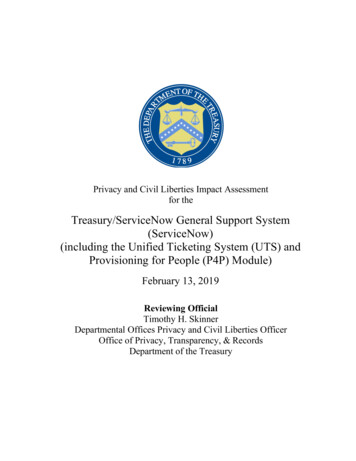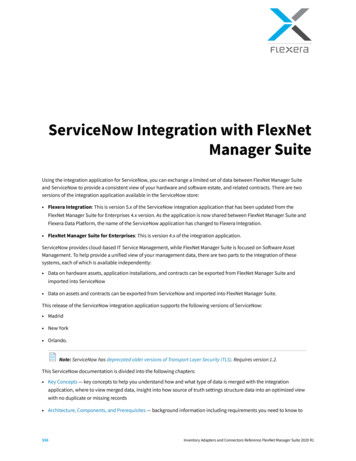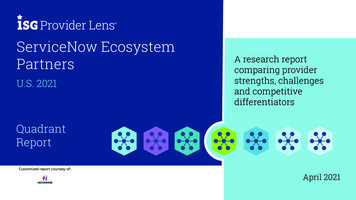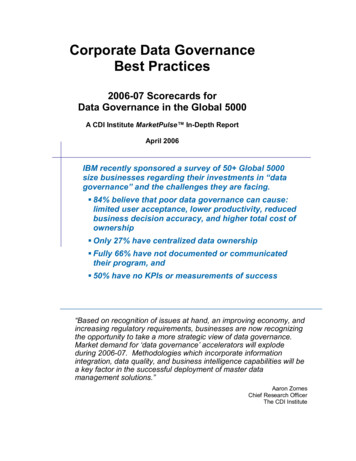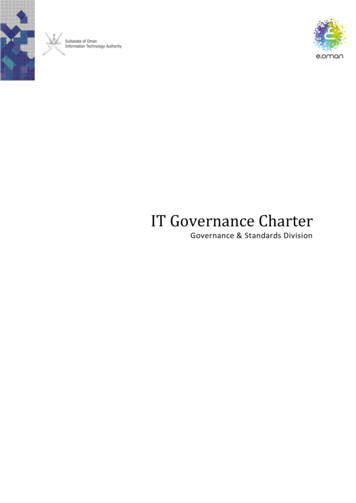
Transcription
SUCCESS WORKBOOKGet started withServiceNowgovernanceDeveloped by the ServiceNow Best PracticeCenter of ExcellenceFebruary 2021
SUCCESS WORKBOOKWhat is ServiceNow governance?Governance is a decision-making framework that defines how ServiceNow strategy, portfolio, and technical decisions are made and who has theauthority to make them.ServiceNow recommends a governance model with three governanceboards, each specializing in one type of decision-making (i.e. strategy,portfolio, or technical).Good governance streamlines the decision-making required to clearly definehow your organization should use and manage the Now Platform.What’s the difference between my strategy,my operating model, and my governance?Your strategy describes what you will do, in terms of both: The business outcomes and value you plan to capture The ServiceNow workflows you’ll implement to realize outcomes and valueYour executive sponsor and/or Center of Excellence and Innovation leadershould set and approve your strategy.Your operating model shows how you will realize your business outcomes. Itdescribes the capabilities you need to create and deliver value using thedigital workflows you implement on the Now Platform.Your governance model provides the decision-making rigor and clarity youneed to make sure that your operating model works within the constraints ofyour business strategy and technical environment.2
SUCCESS WORKBOOKWhy should I invest in governance?You’ll need to make many decisions as you implement and manage the NowPlatform, like: What services to deliver using ServiceNowHow to sequence implementationsHow to manage upgradesWhen to customize as opposed to adopt out-of-the-box (OOTB)functionalityThe point of governance is to structure and streamline how your organizationmakes decisions like these, without frequent, chaotic, and ad hoc escalationsto senior leadership.Good ServiceNow governance will: Drive your transformation vision – Effective decision-making avoids wastedeffort and prioritizes high-value projects by aligning ServiceNow strategyand investment decisions with your broader enterprise goals. Deliver outcomes faster – Governance helps your organization get the rightwork done faster by providing clear direction to teams that implement andmanage ServiceNow at your organization. Minimize technical and business risk – Governance is key to how you defineand apply technical best practices to minimize risk and maintain platformintegrity.What will this workbook help me do?When you complete the steps in this workbook, you’ll have ServiceNowgovernance that: Structures how your decision-making groups (that is, governance boards)make informed decisions that guide how you deliver value with the NowPlatformMakes sure that ServiceNow projects and investments align with yourstrategy, oversees how you manage your ServiceNow portfolio, and defineswhat policies you need to follow to have platform stabilityImproves over time—by measuring and improving governance processefficiency—so your governance delivers value without becomingburdensome red tapeHow to use this Success WorkbookThis workbook will guide you through the steps to get started with ServiceNowgovernance.Start by reading through the Workbook Checklist and review the steps andtasks to get started with ServiceNow governance. From the checklist page, youcan either proceed through the workbook page by page or navigate only tothe sections that you need using the hyperlinks.Each section includes “check your progress” questions that you can answer totest whether you need to complete the tasks listed on that page or if you’vealready done so and should move forward. Hyperlinks are included throughoutthe workbook so you can navigate back and forth between the checklistpage and different sections.3
SUCCESS WORKBOOKWorkbook Checklist: Get started withServiceNow governanceStep 1: Prepare to implement ServiceNow governanceAssign someone to design your governance program and coordinate itsimplementationUnderstand the technology governance requirements at yourorganizationBuild a project plan for how you’ll implement ServiceNow governance atyour organizationGain executive sponsorship for governanceEngage stakeholders who should be involved in implementinggovernanceStep 2: Build your governance modelSet up an executive steering board to support strategic decision-makingSet up a technical governance board to lead technical governanceSet up a demand board to lead portfolio governanceDefine how information flows to and across governance boards toinform decision-makingDefine how to identify and escalate decision-making needsStep 3: Define your governance policiesDefine a set of guiding principles or golden rulesDefine technical governance policies and standards that define howthe Now Platform should be managedStep 4: Build a plan for continuously improving governanceSet metrics to measure the effectiveness of governance at yourorganizationContinually assess and improve governance performance4
SUCCESS WORKBOOKStep 1a: Assign someone to design your governance program andcoordinate its implementationYour governance program will define how your organization makes thedecisions that will guide your ServiceNow implementation. Getting thisright requires careful program planning and design from the start. This isbest managed by assigning overall accountability for governanceimplementation to a single leader.Check your progress:q Is someone accountable for implementing ServiceNow governance?q Is this person a leader with the right authority and experience to effectivelylead governance design and implementation?If you answered “yes” to both questions above, proceed to the next step. Ifnot, complete these action steps to complete this step:1.Assign someone to design your governance program and coordinate itsimplementationThis person will be accountable for completing the steps in this document,including: Leading in defining the scope, direction, and goals for yourgovernance program Designing a project plan for implementing ServiceNow governance Identifying and engaging people that need to be involved inimplementationPlatform owners are typically best positioned to fulfill the responsibilitieslisted above.If the platform owner needs additional help, they should first recruit aprogram manager to support planning and coordination and then involveothers only as needed.Practitioner insight: Make sure the people tasked with setting upgovernance understand the non-technical elements of ServiceNowgovernanceYour Now Platform owner usually has both the technical andstrategic perspectives required to set up an effective governanceprogram that extends beyond basic platform management. Involveother people with experience in strategic planning and whounderstand the business challenges as needed, if the platformowner in your organization is primarily technically focused. Platformarchitects and business analysts, for example, usually have theexperience and know-how to provide this business perspective.Return to workbook checklist5
SUCCESS WORKBOOKStep 1b: Understand the technology governance requirements atyour organizationMost organizations have an existing technology governance model.While the scope of ServiceNow governance is limited to governing theNow Platform, it’s critical that your approach fits with any existingtechnology governance requirements. For example, how will strategicdecisions about how to use ServiceNow need to consider prevailingenterprise platform strategy? How does a ServiceNow-specificdemand process align with the existing demand management processat your organization? How should ServiceNow be managed accordingto enterprise-wide architecture and security requirements?This is especially important in organizations where ServiceNow is astrategic platform and/or when ServiceNow is highly integrated withother platforms. It’s critical that you understand this context before youstart designing and implementing ServiceNow-specific governance.Check your progress:q Do I know about all relevant existing governance and compliancerequirements in my organization?q Do I know how to align ServiceNow governance design with our existingtechnology governance model?If you answered “yes” to both questions above, proceed to the next step. Ifnot, complete these action steps to complete this step:1.Identify any existing technology governance model requirements and/orpolicies that should be considered when designing your ServiceNowgovernance approach.Learn about your organization’s technology governance policies,requirements, and governance bodies/structure so that you know how toalign your implementation of ServiceNow governance. Note specificpolicies that should be considered when defining your own ServiceNowspecific policies later on.2.Make a list of anything you learned about technology governance at yourorganization that you should keep in mind as you design and implementyour ServiceNow governance model.For example, does your organization use specific terminologies that youshould adopt instead of the terms used in this workbook? Are thererestrictions or design guidelines for how to set up new governance modelsat your organization? Consult with technology governance experts at yourorganization (typically in your enterprise architecture function) forguidance.6
SUCCESS WORKBOOKPractitioner insight: Consider how your organization’s decision-making culture should influence how youstructure decision-making for ServiceNowYour organization’s culture should also influence how you design and position your ServiceNowgovernance approach to ensure it’s most likely to be accepted and followed. For example, if yourorganization is process oriented and has experience with governance, it might appreciate a moredetailed and rigid structure up front because it’s easier to follow and strictly adhere to. If governance isa newer concept, you may opt to ease into governance more slowly to avoid it being criticized as redtape.Return to workbook checklist7
SUCCESS WORKBOOKStep 1c: Build a project plan for how you’ll implement ServiceNowgovernance at your organizationApproach implementing governance with a similar rigor that you applyto technical implementations. Set goals and make a plan.Check your progress:q Is there a defined vision for what ServiceNow governance will deliver?q Is there a project plan with a defined timeline for implementing ServiceNowgovernance?If you answered “yes” to both questions above, proceed to the next step. Ifnot, complete these action steps to complete this step:1.Define a vision statement for what ServiceNow governance will deliver atyour organization.We suggest something like “ServiceNow governance will simplify decisionmaking to accelerate platform implementation and outcomes by defininghow the right people can effectively make the right decisions.”2.Document your project plan for implementing governance.Define specific steps for how you will implement governance, following atleast the steps included in this workbook. Set a timeline with deadlines foreach step. Use this governance project plan template, organized using thesame tasks as this workbook, to get started.TaskAssign someone to design yourgovernance program andcoordinate its implementationResearch how decisions aremade at your organizationBuild a project plan for howyou’ll implement ServiceNowgovernance at yourorganizationGain executive sponsorship forgovernanceEngage stakeholders that shouldbe involved in implementinggovernance Assignedto StartdateEnddate Return to workbook checklist8DurationStatus
SUCCESS WORKBOOKStep 1d: Gain executive sponsorship for governanceYou need leadership support to get started with ServiceNowgovernance. Find leaders who understand the value of governanceand will help you establish it at your organization, starting with yourexecutive sponsor.Check your progress:q Have you built a business case that explains why governance is worthimplementing?q Have you shared this business case with your executive sponsor and gottentheir support?q Has your executive sponsor gotten their peer leaders to also support yourcase?If you answered “yes” to all questions above, proceed to the next step. If not,complete these action steps to complete this step:1.Build a business case for why your organization needs ServiceNowgovernance.Leaders understand and respect business cases, and a well-structuredcase can very effectively deliver your pitch for governance. You can dothis in two ways: First, clearly articulate the outcomes you expect from implementinggovernance. We often cite that governance can “help drive yourtransformation vision by aligning all ServiceNow investments to supportstrategy, deliver the right work at the right time by streamlining decisionsand removing roadblocks, and maintain the integrity of yourServiceNow implementation by defining and applying technical bestpractices.” Second, tell stories of previous issues that exemplify the cost of nothaving structured decision-making (e.g., delayed projects because ofescalation roadblocks).Simple, clear, “back-of-the-envelope” calculations on the value ofgovernance, supported by stories from previous projects, can help youmake your case.2.Present your project plan and business case to your executive sponsor, askfor their support.3.Support your executive sponsor’s efforts to gain wider executive buy-inand support for ServiceNow governance.Arm your executive sponsor with your business case, project plan, and anyother supporting resources they ask for so they can be effectiveadvocates for your ServiceNow governance implementation. Refer to thisplaybook on how to work with your executive sponsor, if needed.Return to workbook checklist9
SUCCESS WORKBOOKStep 1e: Engage stakeholders who should be involved inimplementing governanceConduct a stakeholder analysis to Identify what roles and groupsshould be involved in establishing ServiceNow governance and howthey’ll contribute. This analysis often reveals both who you’ll need towork with directly in order to set up governance and who will need tobe involved in ServiceNow governance functions once they’reestablished.Check your progress:q Do I know everyone who should be involved in implementing governance?q Have I defined how each stakeholder should contribute to implementation?q Have I spoken to each stakeholder and set expectations with them?If you answered “yes” to all questions above, proceed to the next step. If not,complete these action steps to complete this step:1.Identify who should be involved in implementing ServiceNow governance.Make a list of the groups you identify. This list will be different at everyorganization but will generally involve at least someone from these groups: ServiceNow executive sponsor ServiceNow platform team IT/domain leaders Service and process owners Program managers (PMO) Enterprise architects Information security teamPractitioner insight: Involve people with both technical and businessskills when you set up your governance programAll too often, organizations think of governance only in terms ofcontrolling what happens on the technology—and then they designa governance program that focuses only on technical standardsand management. The consequence is that the responsibility forsetting up governance often defaults to the staff with technical skills.But if your organization is looking for transformation, the mostimportant governance decisions to frame aren’t technical—they’reabout the strategic direction of the ServiceNow roadmap and howtechnical decisions align with and support that. The people whodesign and set up your governance program need to balance anunderstanding of business as well as technical needs.10
SUCCESS WORKBOOK2.Build a stakeholder map that shows who needs to be involved in setting up ServiceNow governance and what theycan contribute.Your platform owner (and any others working to set up ServiceNow governance) must coordinate with other groupsto ensure your ServiceNow governance program fits within the context of existing enterprise governance andpolicies. Unfortunately, many groups overlook this need because they don’t have a strong sense of whom to involveand how to work with them. To avoid this, brainstorm a list of stakeholders who might need to be involved when youinitially set up ServiceNow governance.Map these different stakeholder groups—such as your executive sponsor, the PMO, and process owners—anddefine what you think each stakeholder can help contribute to your governance program. The map will be differentat every organization but will generally involve at least the groups and tasks included here:Governance setuprole(s) (e.g., platformowner) Sets up governancecommittee structure Coordinatesgovernancedecision-makingprocesses Documents andupdatesgovernance policyand process Collaborates withenterprise processfunctionsServiceNow executive sponsor Advises governance setup group on governance model design Chairs executive steering committee Secures funding for governance Vets established governance with senior leadersProgram manager (PMO) Coordinates the work needed to set up governance Checks that ServiceNow governance aligns with IT and compliance needsServiceNow platform team Identifies where governance is needed to manage the platformService owners Identify where governance is needed for their service Apply governance in their serviceProcess owners Identify where governance is needed for their process Apply governance in their processArchitects/platform architects Support technical governance set up, including collaborating on definingguiding principles, controls, and how to apply technical governance acrossdelivery activities3.Meet with the stakeholders/groups you identified, share your vision and project plan with them, and discuss whatmight be expected of them as part of the implementation.This conversation should also cover how they may be involved in ServiceNow governance after it’s implemented.Practitioner insight: Be prepared to sell ServiceNow governance to your stakeholdersWhen engaging stakeholders, always start with a pitch that explains ServiceNow governance and itsbenefits. It is especially important to emphasize the benefits of good governance if your organization hasany aversion to the concept of governance or if past governance initiatives have failed.If you expect resistance, organizational change management (OCM) practices might complement yourgovernance implementation to help you engage your stakeholders and prepare them for any changesresulting from adopting a ServiceNow governance model.Don’t be disheartened if your pitch for governance is initially criticized. In one extreme example, ourcustomer at a Fortune 500 pharmaceutical company shared, “When I started, I couldn’t even use theword ‘governance’ at my organization because it’s too deeply associated with red tape.” Ultimately, thiscustomer was able to foster support for adopting ServiceNow governance by working with theirstakeholders and consistently explaining the benefits.Return to workbook checklist11
SUCCESS WORKBOOKStep 2a: Set up an executive steering board to lead strategygovernanceStrategy governance, led by an executive steering board, defines howstrategy roadmap decisions are made to align ServiceNowfunctionality to business outcomes. Start by defining who must beinvolved in strategic roadmap decisions for ServiceNow, then definehow this group makes informed decisions.Check your progress:q Do you have a group of leaders who meet periodically to make strategicdecisions to use ServiceNow to support desired business outcomes at yourorganization?q Does this group have a defined remit that bounds what types of decisionsthey need to be involved in?q Does this group apply a consistent decision-making process?If you answered “yes” to all questions above, proceed to the next step. If not,complete these action steps to complete this step:1.Recruit your executive sponsor to chair the executive steering board.Establish an executive steering board, led by the executive sponsor, tooversee strategy governance.2.Set a charter for you executive steering board.We recommend that this board aspire to:3. Drive success of the ServiceNow program by aligning and prioritizinginvestments with business goals and available delivery capabilities Monitor and direct programs to protect benefits and mitigate programrisks Be accountable for the ServiceNow program, projects, and roadmapWork with your executive sponsor to recruit other stakeholders to theboard.One of the most important steps in establishing strategy governance is todefine who needs to be directly involved in decision-making processesthat determine how your organization will use and govern ServiceNow.Take great care when you select who should participate in thesedecisions. Keep the board as small as possible to start.Consider asking the following roles to participate in executive steeringboard decision-making: Executive sponsor CIO/CTO Key suppliers and partners Business unit/department representatives Vendor managers12
SUCCESS WORKBOOK4.Define what decisions and responsibilities need to be managed by the executive steering board.Consider what outcomes you expect from your board. Then make a list of decisions and actions that your executivesteering board will be responsible for.To start, here are the most important decisions the executive steering board needs to make: Does the current ServiceNow roadmap align with your business objectives? How will we revisit and update the ServiceNow vision and roadmap over time? Do we have the right partners and partner management in place?Here’s an example of how you can structure what you define, using a template we’ve used while working with othercustomers. Note that the output of action steps 1–3 can also be included in this template.Executive steering board 5.Drive success ofthe ServiceNowprogram byaligning andprioritizinginvestments withbusiness goalsand availabledeliverycapabilitiesMonitor anddirect programsto protectbenefits andmitigateprogram risksAccountable forthe ServiceNowprogram,projects, androadmapResponsibilities anddecisionsMembersCharter ServiceNowexecutive sponsor(lead) Platform owner Business unitexecutives (liveprocesses andcurrent projects) Projectmanager(s)(current projects)Processmanager(s)Platform architect Optional/guests:Drive success ofthe ServiceNowprogram byaligning andprioritizingdemand withbusiness goalsand availabledeliverycapabilitiesResolveescalations andconflicts ofinterestsEnsure projectdependenciesare identified andshared amongthe projects Quality manager Compliance andauditOptimize riskposition EnterprisearchitectOversee anddirect benefitsrealizationOutcomesTypical agenda Aligned roadmap Aligned releasescheduleStrategy anddemand review Alignment andprioritization ofplatform strategyand projects Project(s) status Project(s)planningalignment Capacity review Release scheduleapproval Enhancementsreview andapproval Release scheduleapprovals Releaseprioritization Approveenhancements Approve platformarchitecture boardrecommendations Aligned projectdependenciesPlatform upgradealignmentSet a cadence for executive steering board meetings.We recommend that the executive steering board meet once every three to six months, at least.Practitioner insight: Be mindful not to rely only on a cadence of governance board meetings to provideeffective governance.Cadence doesn’t structure what decisions are made or how they are made. Focus on defining how tosupport the decision-making process that those boards should follow.13
SUCCESS WORKBOOK6.Define specifically how the executive steering board will make decisions.Define a process for how your board will make governance decisions. Make sure your process explicitly prioritizes themost important action items from your backlog.Consider whether decisions are made by majority-rules voting, consensus, seniority, or some other mechanism.7.Plan how to support your executive steering board’s decision-making.It isn’t enough to simply get the right leaders in the same room. You need to plan for how you will prepare yourboard to focus on the right priorities when they meet. Plan for how you can do the following items before and duringeach board meeting: Set an agenda. Maintain a backlog of the items that your board needs to discuss during their next meeting.Prioritize these items to ensure that the most important and urgent needs are addressed. Provide relevant information so your board can make informed decisions. For the executive steering board, thisinformation can include the:o Most up-to-date ServiceNow vision, business case, program plan, and roadmapo Most up-to-date ServiceNow performance dashboard reportso Notes from past board meetings, including those from other boards (i.e., the demand board and/ortechnical governance board) Take meeting notes to record decisions made by the board so they can be articulated into policies that yourorganization can follow, as needed.Return to workbook checklist14
SUCCESS WORKBOOKStep 2b: Set up a technical governance board to lead technicalgovernanceTechnical governance, led by a technical governance board, governsthe management and stability of the ServiceNow support model. Startby defining who must be involved in technical decisions forServiceNow, then define how this group makes informed decisions.Check your progress:q Do you have a group of leaders who meet periodically to make technicaldecisions about how to manage the Now Platform and guideimplementation?q Does this group have a defined remit that bounds what types of decisionsthey need to be involved in?q Does this group apply a consistent decision-making process?If you answered “yes” to all questions above, proceed to the next step. If not,complete these action steps to complete this step:1.Recruit someone to chair the technical governance board.Establish a technical governance board, led by the ServiceNow platformarchitect and/or platform owner, to oversee technical governance.2.Set a charter for your technical governance board.We recommend that the technical governance board aspire to:3. Be the decision body and gate keeper on platform-related technicalaspects Assess technical and design options and approaches Assess development standards, best fit usage, UI standards, datagovernance/strategy are among the tools used by this groupWork with your chair to recruit other stakeholders to the board.One of the most important steps in establishing technical governance is todefine who needs to be directly involved in decision-making processesthat determine technical standards for how the platform is used andmanaged. Take great care when you select who should participate inthese decisions. Keep the board as small as possible to start.Consider asking the following roles to participate in technical governanceboard decision-making: Platform architect Quality assurance lead Platform owner Security/compliance lead IT domain owners Development lead Program manager(s) User experience lead Business analysts15
SUCCESS WORKBOOK4.Define what decisions and responsibilities need to be managed by the technical governance board.Consider what outcomes you expect from your board. Then make a list of decisions and actions that your technicalgovernance board will be responsible for.To start, here are some decisions the technical governance board needs to make: How should we manage the technical aspects of implementations and upgrades? What technical standards should we adhere to for engineering, development, and integration?Here’s an example of how you can structure what you define, using a template we’ve used while working with othercustomers. Note that the output of action steps 1–3 can also be included in this template.Technical governance board 5.Responsibilities anddecisionsMembersCharterBe the decisionbody and gatekeeper onplatform relatedtechnicalaspects Platform architect(lead) Platform owner Developmentleads (eachproject)Assess technicaland designoptions andapproaches Assessdevelopmentstandards, bestfit usage, UIstandards, datagovernance/strategy areamong the toolsused by thisgroup Security lead Interface owner(source/targetsystem) Projectmanager(s) Vendor(ServiceNow)architect Platform leadadministrator Optional/guests:Decision bodyand gate keeperon platformrelated technicalaspectsDesign authorityon platformcustomizationsand integrationsMaintain designdecision register ofapproved,rejected designdecisions Maintain technicaldebt register forperiodic reviewand removal oftechnical debt Provides advisoryandrecommendationsto the programsteeringcommittee andproject(s) Enforcement ofplatform qualityand upgradability Advisory forprojects,operations, andexecutive boardsOutcomesTypical agenda Approvals forsolution designs Review technicalrequests Guidance onrequests fortechnical supportfrom projects Evaluation of newdemands,stories, andrequirements Technical designapprovals forcustomizationsand integrations Evaluation ofrequirements Review of releasecontent (technicalreview) Technical releaseapproval Release planningrecommendationsto steeringcommittee Approvals onplatform wideaspects Reviewhigh/criticalincidents that wereaddressed to theCAB (changeadvisory board) Approve andreview pluginenablement oneach instanceDecisions onrequests thathave an impacton the platformSet a cadence for technical governance board meetings.We recommend that the technical governance board meet at least every 1–2 months. However, they will also needto convene for point-in-time decision-making as needed (e.g., to handle an issue or question elevated fromimplementation teams so they can stay on schedule).16
SUCCESS WORKBOOK6.Define specifically how the technical governance board will make decisions.Define a process for how your board will make governance decisions. Make sure your process explicitly prioritizes themost important ac
Document your project planfor implementing governance. Define specific steps for how you will implement governance, following at least the steps included in this workbook. Set a timeline with deadlines for each step. Use this governance project plan template, organized using the same tasks as this workbook
